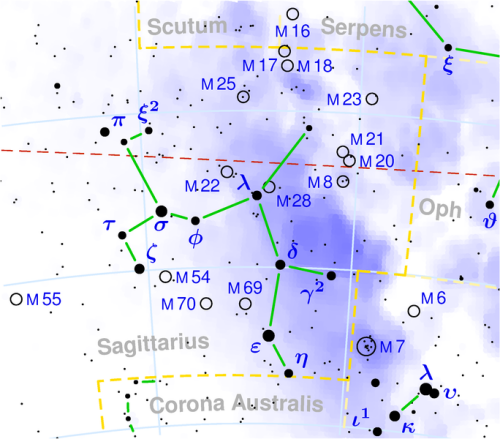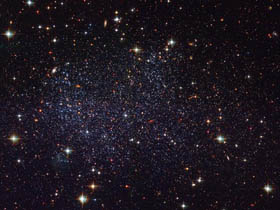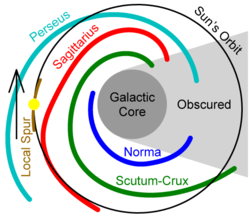Sagittarius

Sagittarius. © 2003 Torsten Bronger.
Sagittarius (abbreviation: Sgr), the Archer (actually, a centaur with a bow), is a large constellation of the southern hemisphere and ninth of the zodiac. It lies north of Corona Australis, south of Aquila, east of Capricornus and west of Ophiuchus. In the center of the constellation lies the conspicuous asterism known as the Milk Dipper or the Teapot, with a spout (formed by the stars Gamma, Delta, and Epsilon Sag), a handle (Zeta, Sigma, Tau, and Phi Sag), and a lid (Lambda Sag).
Rich in star fields, star clusters, and nebulae, Sagittarius straddles the plane of the Milky Way. At its very edge, at the border with Ophiuchus and Scorpius, lies the center of the Milky Way Galaxy, about 30,000 light-years distant. See below for details of the constellation's brightest stars and interesting deep sky objects.
Sagittarius Dwarf Irregular Galaxy
 |
The Sagittarius Dwarf Irregular Galaxy (SagDIG, Sag dIrr) is a dwarf irregular galaxy, discovered in 1977, that is a member of the Local Group of galaxies. It has a diameter of about 3,000 light-years and lies about 3,500 light-years away in Sagittarius at celestial coordinates RA 19h 30m, Dec –17° 42'.
Sagittarius Arm
 |
The Sagittarius Arm, also known as the Sagittarius-Carina Arm, is one of the spiral arms of the Milky Way Galaxy. It lies between the Sun and the center of the Galaxy in the direction of the constellation of Sagittarius.
| Stars in Sagittarius brighter than magnitude 4.0 | ||||||
|---|---|---|---|---|---|---|
| star | vis mag | abs mag | spec type | distance (ly) | RA (h m s) | Dec (° ' ") |
| Epsilon (Kaus Australis) | 1.79 | -1.45 | B9.5III | 145 | 18 24 10 | -34 23 05 |
| Sigma (Nunki) | 2.05 | -2.14 | B2.5V | 224 | 18 55 16 | -26 17 48 |
| Zeta (Ascella) | 2.60 | 0.41 | A2III+A4IV | 89 | 19 02 37 | -29 52 49 |
| Delta (Kaus Media) | 2.72 | -2.14 | K3IIIa | 306 | 18 21 00 | -29 49 42 |
| Lambda (Kaus Borealis) | 2.82 | 0.94 | K1IIIb | 77 | 18 27 58 | -25 25 18 |
| Pi (Albaldah) | 2.82 | -2.77 | F2II | 440 | 19 09 46 | -21 01 25 |
| Gamma (Alnasl) | 2.98 | 0.63 | K0III | 96 | 18 05 48 | -30 25 26 |
| Eta | 3.10 | -0.20 | M2III | 149 | 18 17 38 | -36 45 42 |
| Phi | 3.17 | -1.08 | B8III | 231 | 18 45 39 | -26 59 27 |
| Tau | 3.32 | 0.48 | K1III | 120 | 19 06 56 | -27 40 13 |
| Xi-2 | 3.52 | -1.77 | G8II | 372 | 18 57 44 | -21 06 24 |
| Omicron | 3.76 | 0.61 | K0III | 139 | 19 04 41 | -21 44 30 |
| Mu (Polis) | 3.84v | -8.15 | BIape | 8,150 | 18 13 46 | -21 03 32 |
| Rho-1 | 3.92 | 1.06 | F0III | 122 | 19 21 40 | -17 50 50 |
| Beta-1 (Arkab Prior) | 3.96 | -1.37 | B9V | 378 | 19 22 38 | -44 27 32 |
| Alpha (Rukbat) | 3.96 | 0.37 | B8v | 170 | 19 23 53 | -40 36 58 |
| Other objects of interest | ||
|---|---|---|
| name | type of object | notes |
| W Sgr | star | A Cepheid variable. Magnitude range 4.4 to 5.0; period 7d 14h; RA 18h 5.0m, Dec -29° 35' |
| NGC 6818 | planetary nebula | Irregular oval shape. Magnitude 10; diameter 0.3'; RA 19° 44' |
| Lagoon Nebula | diffuse nebula | M8. See separate entry |
| Omega Nebula | diffuse nebula | M17. See separate entry |
| Trifid Nebula | diffuse nebula | M20. See separate entry |
| M18 (NGC 6613) | open cluster | A loose scattering of about 20 stars over 0.2° best viewed with binoculars or a small telescope. Magnitude 6.9; diameter 9'; RA 18h 19.0m, Dec -17° 8' |
| M21 (NGC 6531) | open cluster | Easy to resolve with a tight central grouping. Magnitude 6.9; diameter 9'; R.A. 18h 19.0m, Dec. -17° 8' |
| M23 (NGC 6494) | open cluster | A large cluster spanning nearly 0.5o, excellent with binoculars and resolvable with a small telescope into about 100 stars. Magnitude 5.5; diameter 27'; RA 17h 56.8m, Dec -19° 1' |
| M25 (IC 14725) | open cluster | About 50 stars, the brightest of sixth magnitude; good binocular object. Magnitude 4.6; diameter 31'; RA 18h 31.6m, Dec -19° 15' |
| NGC 6530 | open cluster | About 25 stars near the Lagoon Nebula, the brightest of seventh magnitude; another good binocular cluster. Magnitude 4.6; diameter 14'; RA 18h 4.8m, Dec -24° 20' |
| M24 | star field | The Sagittarius Star Cloud, part of Milky Way. To naked eye, it appears as a foggy patch; large telescopes reveal a rich field of stars. Magnitude 4.6; diameter 90'; RA 18h 16.9m, Dec -18° 29' |
| M28 (NGC 6626) | globular cluster | Magnitude 6.9; diameter 11.0'; RA 18h 24.5m, Dec -24° 52' |
| M54 (NGC 6715) | globular cluster | Close to Zeta Sgr and lying within the Sagittarius Dwarf Elliptical Galaxy, it is so dense that it is can mistaken through binoculars for a star. Magnitude 7.7; diameter 9.1'; RA 18h 55.1m, Dec -30° 29' |
| M55 (NGC 6809) | globular cluster | A large but loose globular that can be viewed with binoculars. Magnitude 6.9; diameter 19.0'; RA 19h 19.0m, Dec -17° 8' |
| M69 (NGC 6637) | globular cluster | Magnitude 7.7; diameter 7.1'; RA 18h 31.4m, Dec -32° 21' |
| M70 (NGC 6681) | globular cluster | Magnitude 8.1; diameter 7.8'; RA 18h 43.2m, Dec -32° 18' |
| M75 (NGC 6864) | globular cluster | Magnitude 8.6; diameter 6.0'; RA 20h 06.1m, Dec -21° 55' |
| Sagittarius Dwarf Elliptical Galaxy | galaxy | See separate entry |
| Sagittarius A | galaxy | See separate entry |
| Constellations |
| Andromeda | Antlia | Apus | Aquarius | Aquila | Ara | Aries | Auriga | Bootes | Caelum | Camelopardalis | Cancer | Canes Venatici | Canis Major | Canis Minor | Capricornus | Carina | Cassiopeia | Centaurus | Cepheus | Cetus | Chamaeleon | Circinus | Columba | Coma Berenices | Corona Austrina | Corona Borealis | Corvus | Crater | Crux | Cygnus | Delphinus | Dorado | Draco | Equuleus | Eridanus | Fornax | Gemini | Grus | Hercules | Horologium | Hydra | Hydrus | Indus | Lacerta | Leo | Leo Minor | Lepus | Libra | Lupus | Lynx | Lyra | Mensa | Microscopium | Monoceros | Musca | Norma | Octans | Ophiuchus | Orion | Pavo | Pegasus | Perseus | Phoenix | Pictor | Pisces | Piscis Austrinus | Puppis | Pyxis | Reticulum | Sagitta | Sagittarius | Scorpius | Sculptor | Scutum | Serpens | Sextans | Taurus | Telescopium | Triangulum | Triangulum Australe | Tucana | Ursa Major | Ursa Minor | Vela | Virgo | Volans | Vulpecula |


